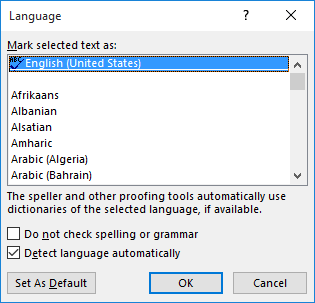Please Note: This article is written for users of the following Microsoft Word versions: 2007, 2010, 2013, 2016, 2019, 2021, and Word in Microsoft 365. If you are using an earlier version (Word 2003 or earlier), this tip may not work for you. For a version of this tip written specifically for earlier versions of Word, click here: Changing between English Variants.
Written by Allen Wyatt (last updated April 8, 2023)
This tip applies to Word 2007, 2010, 2013, 2016, 2019, 2021, and Word in Microsoft 365
English is English, right? No, it is not. Ask anyone who works with international documents; they know that there are many variations of English. For instance, in US English words that are spelled one way (organize, catalog, behavior, etc.) are spelled differently in UK English (organise, catalogue, behaviour, etc.). The upshot of these variations is that you may also need to produce different versions of your documents for audiences that use the different language variations.
The traditional way of doing the conversion from one variation to another is straightforward:

Figure 1. The Language dialog box.
If you do a lot of textual conversions, going through these steps can become very routine, to the point of tedium. It would seem to be a simple thing to simply change the spellings from one English variation to another, without the need for manual review in this manner. Unfortunately, Word doesn't provide such a feature. You can, however, create a macro that would do the conversions for you. Follow these general steps:
You now have a macro that will do a conversion from one variation to the other. Later, as you become aware of more words that need to be automatically replaced, you can edit the macro and add those words.
WordTips is your source for cost-effective Microsoft Word training. (Microsoft Word is the most popular word processing software in the world.) This tip (10172) applies to Microsoft Word 2007, 2010, 2013, 2016, 2019, 2021, and Word in Microsoft 365. You can find a version of this tip for the older menu interface of Word here: Changing between English Variants.

Do More in Less Time! An easy-to-understand guide to the more advanced features available in the Microsoft 365 version of Word. Enhance the quality of your documents and boost productivity in any field with this in-depth resource. Complete your Word-related tasks more efficiently as you unlock lesser-known tools and learn to quickly access the features you need. Check out Microsoft 365 Word For Professionals For Dummies today!
English is written left to right, but some languages are right to left. Mixing the two in a document can present a ...
Discover MoreWhen copying information into a Word document, you may want to make sure that the information pasted is formatted as a ...
Discover MoreThere you are typing along, minding your own business, when wham! You end up in an entirely different language and you ...
Discover MoreFREE SERVICE: Get tips like this every week in WordTips, a free productivity newsletter. Enter your address and click "Subscribe."
There are currently no comments for this tip. (Be the first to leave your comment—just use the simple form above!)
Got a version of Word that uses the ribbon interface (Word 2007 or later)? This site is for you! If you use an earlier version of Word, visit our WordTips site focusing on the menu interface.
Visit the WordTips channel on YouTube
FREE SERVICE: Get tips like this every week in WordTips, a free productivity newsletter. Enter your address and click "Subscribe."
Copyright © 2026 Sharon Parq Associates, Inc.
Comments